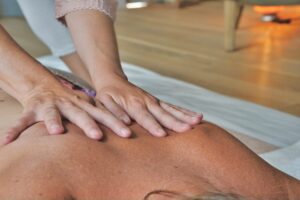Performing push-ups is an effective way to build upper body strength and overall fitness. However, the aftermath of a rigorous push-up session can often leave you with muscle soreness. While it’s a natural part of the muscle-building process, there are ways to alleviate and speed up the recovery process. In this article, we’ll explore some effective tips for reducing muscle soreness after push-ups and getting you back into your workout routine with minimal discomfort.
Understanding Muscle Soreness
Before delving into recovery strategies, it’s essential to understand why muscle soreness occurs. When you perform push-ups or any form of resistance training, you create microscopic damage to muscle fibres. This damage, often referred to as muscle microtrauma, is a normal part of the muscle-building process. As your body repairs and rebuilds these fibres, you experience muscle soreness, also known as delayed onset muscle soreness (DOMS).
While muscle soreness is a sign that your muscles are adapting and becoming stronger, it can be uncomfortable. The good news is that there are several strategies to help alleviate this soreness and promote faster recovery.
Tips for Reducing Muscle Soreness After Push-Ups
1. Cool Down Properly
After completing your push-up workout, take a few minutes to cool down. Gentle stretching can help improve flexibility and reduce muscle stiffness. Focus on stretching the chest, shoulders, triceps, and other muscles engaged during push-ups. Hold each stretch for about 15-30 seconds, breathing deeply to promote relaxation.
2. Hydrate and Replenish Electrolytes
Proper hydration is crucial for muscle recovery. Water helps flush out toxins from your muscles and keeps your body functioning optimally. Additionally, if your push-up session has been particularly intense and has led to sweating, you may need to replenish electrolytes. Consider drinking a sports drink or consuming foods rich in electrolytes to help restore the balance of minerals in your body.
3. Apply Ice or Heat
The application of ice or heat can help reduce inflammation and soothe sore muscles. Ice is effective for reducing swelling, while heat can promote blood flow and relaxation. You can use ice packs or a bag of frozen peas wrapped in a thin towel for icing, and a warm shower or heating pad for heat therapy. Apply for about 15-20 minutes, allowing your muscles to benefit from the therapeutic effects.
4. Massage and Foam Rolling
Massage, whether performed by a professional or through self-massage techniques, can help relieve muscle tension and improve circulation. If a professional massage is not feasible, using a foam roller is an excellent alternative. Foam rolling, also known as self-myofascial release, can target tight areas and release muscle knots. Focus on rolling out your chest, shoulders, and triceps for effective post-push-up recovery.
5. Rest and Sleep
Allowing your muscles time to rest is crucial for recovery. Avoid overtraining, especially if you’re just starting or intensifying your push-up routine. Aim for 7-9 hours of quality sleep each night as this is when your body performs essential repair and recovery processes. Lack of sleep can hinder muscle recovery and increase feelings of soreness.
6. Anti-Inflammatory Foods
Incorporating anti-inflammatory foods into your post-workout nutrition can help reduce muscle soreness. Foods rich in omega-3 fatty acids, such as fatty fish and flaxseeds, have anti-inflammatory properties. Additionally, including fruits and vegetables high in antioxidants, like berries and leafy greens, can aid in reducing inflammation and promoting recovery.
7. Active Recovery
Engaging in light, low-impact activities on your recovery days can enhance blood flow and aid in the removal of waste products from your muscles. Activities such as walking, cycling, or swimming can be beneficial for reducing muscle soreness without placing additional stress on your body.
8. Pain Relief Creams
Topical pain relief creams or gels containing ingredients like menthol or arnica can provide temporary relief from muscle soreness. These products work by numbing the skin or creating a warming sensation, offering a sense of relief. Be sure to follow the instructions on the product and avoid using them on broken or irritated skin.
Implementing an Effective Recovery Routine
To maximise the benefits of these recovery tips, consider incorporating them into a holistic post-push-up routine. For example, after completing your push-up workout, take a few minutes to cool down with stretches, hydrate, and replenish electrolytes. Follow this with a massage or foam rolling session, and then relax with ice or heat therapy. Finally, ensure you get adequate sleep and continue to practice active recovery on your non-push-up days.
It’s essential to listen to your body and adjust your recovery routine based on your individual needs and preferences. Experiment with different strategies to find what works best for you and fits seamlessly into your lifestyle.
In conclusion, while muscle soreness is a natural part of the muscle-building process, it doesn’t have to be a hindrance to your fitness journey. By incorporating these tips into your post-push-up routine, you can reduce muscle soreness, enhance recovery, and ensure you’re ready for your next workout with a strong and resilient upper body. Remember, consistency in recovery practices is key to maintaining overall fitness and preventing long-term discomfort.



